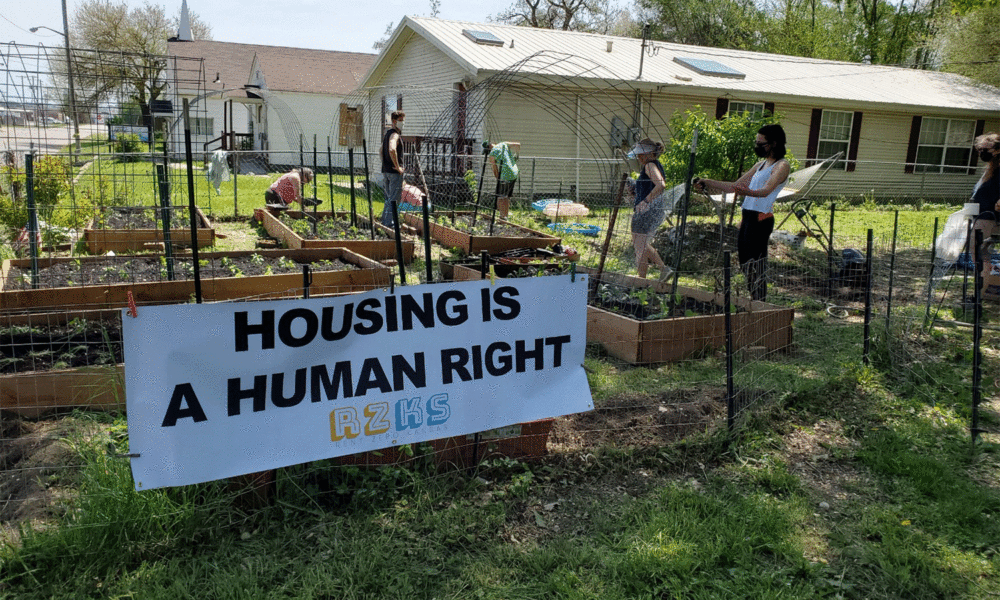Para leer esta entrevista en español, pinchar aquí.
Community general plans are opportunities to envision changes that would address longstanding issues and bring healthier, safer environments for people and their families to live in. In the environmental justice community of Armourdale, Kansas, Beto Lugo-Martínez and his organization CleanAirNow (CAN) are working to ensure that the voices of the people who live and work in the community have a say in what that picture looks like, using data and information they have helped collect and that they understand.
This is critical because Kansas City is facing cumulative impacts from multiple environmental health and safety threats. Industrial facilities, including scrap metal operations, are contaminating the land, water, and air; truck traffic is raising hazardous pollution levels; and increased heat and flooding due to climate change is ever growing. Latinx and Black residents face the greatest environmental risk in Kansas City. Furthermore, the legacy of discriminatory planning practices such as redlining, zoning, and siting of industry; lack of accessible green spaces; and inequities in health care, among other injustices, is impacting people of color.
To ensure that the general plan the local government and consultants are working on adequately acknowledges and works to address these environmental injustices, CleanAirNow and Kansas City community members submitted detailed comments and recommendations.
I spoke with Beto about the work his organization is doing and his hopes for how this effort could bring positive changes to Armourdale and serve as a model for more equitable and just planning in the city, on both sides of the Kansas-Missouri state boundary line.
What are the biggest challenges that the Armourdale community members are living with and is it reflective of Kansas City at large?
Government has the power and often prioritizes funding and resources to the more urban, affluent communities. And this, particularly in Kansas City, dates back to historical issues of how these communities were intentionally designed (we know Kansas City was a model for redlining) so that already puts this community at greater risk of economic inequity, because a line was literally drawn of who gets the wealth.
Most of the people that live in the community of Armourdale moved there because industry was there first. As industry was growing in the area, landowners and facility owners were building homes for their workers setting them up to live near they worked. This to us is one form of environmental racism because these communities have been left to fend for themselves. They don’t have access to good healthcare, green spaces, safe neighborhoods, or community involvement. One thing that’s interesting about Armourdale is that they have a community center but I learned that no one uses it- it’s just a monument for the local government. Community members have never had a voice in anything that happens in the community.
One of the things that’s been voiced by community members is the land use designation of this community. It’s mixed use, both residential and industrial. The impacts that these uses are having on the residents living next to these facilities is huge because there are cumulative impacts. It’s not just one facility that’s causing harm but multiple sources of pollution, so it’s also difficult to pinpoint which one is most harmful to someone’s health.
The life expectancy in this neighborhood is twenty years shorter than other parts of the same county. We can’t attribute it directly to environmental factors, but there is a correlation between health and air pollution, water pollution, and soil pollution. There’s a history of legacy contamination, hazardous waste and toxic facilities, including recycling yards, in this community. Everything else bordering the community is heavy industry so it’s not just what’s bordering the community, it’s what’s in the community that’s harmful to these residents.
There’s also the impacts of the goods movement—local businesses utilize the city as if all the city is their warehouse. They drive back and forth on local roads. When you think about all the facilities and all the trucks idling that emit toxic contaminants in the community and you consider the effects it has on children’s health, like asthma, it’s a huge problem.
What are your hopes for what the Armourdale General Plan could mean for the community?
There was an Armourdale plan back in 1979 that recommended that they shouldn’t develop any more industry in that area, not because of impacts to health but because of impacts to residential dwellings. This plan needs to prioritize community health. What I mean by that is putting resources that can improve community health overall but creating the sense of community which means giving residents an opportunity to weigh in on what’s happening.
When a community member voices something and they include them in the process and take action on it, that’s a sense of community–being informed by community members of what the plan should look like because they’re the ones who experience these harmful impacts first and foremost, so they’re the best people to tell you what needs to be done. But if we continue to allow others to draft what the city should look like, steer questions in the direction that does not reflect the community, there’s a form of bias created by that system.
The comment features important data from an air monitor network that was set up and owned by the community. How have you worked with Kansas City residents to uncover injustices and disparities in air quality?
CleanAirNow was born around community concerns, from both industry and the railyard. As an organization, we take on a lot of these polluters and call them out for their practices, but we also engage in community-led projects that can inform residents of these issues and create leaders in the community so they can advocate for themselves. We help give them the tools, the data, and the information that they can use to speak for themselves with their own stories.
Most recently, our organization has been building community power on the frontlines working with residents and community health workers to engage them around issues of environmental health, environmental justice, air pollution trainings, air monitoring trainings.
The reason we took this route is because we have seen that the work around air monitoring gives community members the ability to understand what’s really happening and to get involved civically: in everything from health projects to local policy, even school curricula. Our work is a multifaceted approach and guided by the community.
We worked with community members to do a mapping activity to identify locations for air monitors. Because the community members understood the impacts to health, they chose to put monitors at community centers, schools, and residential homes. In Armourdale, through the work of our project partners we were able to identify a daycare center that could host a monitor. The participant knew the value of the work and wanted to protect the health of the kids in her care. She realized that having a monitor might help her make a more informed decision not to take kids outside on a bad air quality day, for example. The Unified Government [the Wyandotte County, KS and Kansas City consolidated government entity] had a big interest in our work because they thought this was an innovative project, so I asked if we could put a monitor at one of their buildings, and they agreed to put one at one of their community centers. That was a big deal!
How has CleanAirNow worked to ensure the community voice is listened to during this process? What is missing from their process so far?
Historically, local government has not prioritized community health and trying to improve the quality of life, they’re more interested in their financial gain and it’s evident in this community that their financial gain has been at the expense of the community members who have lived here for several generations. The Unified Government created a steering committee to help inform the General Plan and membership was comprised of agencies and landowners that do not live in the community. We see that as a problem because if you do not live in the community but have an interest in a facility there, your interest is to make more money at the expense of the community. They were missing key participants. It’s an example of environmental racism because the community is not involved, it’s top-down, and industry has the final word.
Being a part of the steering committee, we were able to voice our concerns and inform the process. We told them that as a part of their Armourdale survey, they shouldn’t be biased towards just positive aspects of the community. We also voiced that their public participation plan was not robust enough because this community as described by CAN is an environmental justice community and we know these communities aren’t reached the same way and don’t have the same access to public resources as more affluent communities. A lot of the people they were going to reach have probably never heard of a general plan. So we told them you need to explain to the community what it is and have them inform it every step of the way.
CleanAirNow placed several monitors in Armourdale and we have had many conversations with community members about this general plan process. We created our own materials in Spanish explaining what a general plan is to make sure the information was getting out there. We started drafting the general plan comments, incorporating partner and residents’ concerns and utilizing the air monitoring data we were gathering.
As we were writing the comment, another community member volunteered to put a monitor outside their house in Armourdale, so we have three monitors there and have monitors in other areas nearby. What we’re seeing in this particular community, the air pollution levels are higher than in other places which gives us an understanding of the landscape. Our approach to presenting the data in the comment is equitable- we’ll present it to the planners the same way the community wants to see it. Compiling this information and submitting this comment is an accomplishment of being able to inform a policy using community power. The data came directly from the community members informing where the monitors should be located.
What can governments do to better involve environmental justice communities in decisionmaking processes?
One thing we’re pushing for is that the local government should be transparent in all their processes and really include the community members’ voices when determining priorities for a community, not just the people at agencies or landowners. We have heard from Armourdale residents who have had concerns and complaints about issues related to facilities and when they reach out to local government, they are ignored or are told, “What do you expect? You live in Armourdale.”
Communities like Armourdale across the country are the ones being impacted by climate change and air pollution at the same time. We, as environmental justice activists, have been advocating for policies that protect these communities who are least responsible for climate change impacts. We need to think differently about how to include community voices. The environmental justice movement is shaping community-led policies.

